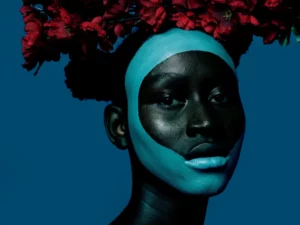The work of Britain’s foremost concrete poet and sculptor Ian Hamilton Finlay (1925–2006) makes references to literature, pre-Socratic philosophy, the French Revolution and classical mythology. In the current exhibition at Victoria Miro entitled 1789 1794 twelve pieces by Finlay that investigate ideas surrounding the French Revolution are displayed over two floors and showcase how the artist was working in a variety of different materials including neon, stone, plaster, slate and wall painting.
The title of this exhibition references the dates of the French Revolution, which for Finlay was an opportunity to explore opposing ideas like liberty and virtue with terror and violence. He wrote: “I have often said that just as the French Revolution, for instance, understood itself through antiquity, I think our time can be understood through the French Revolution.” The white sculpture Aphrodite of the Terror (1987) is a plaster copy of the famous Medici Venus, a life-size classical sculpture of the Greek goddess tenderly caught in a moment of surprise emerging from the sea. The Aphrodite of the Terror has a thin red line around the circumference of her neck, which references French women whose family members were executed via guillotine during the Terror and wore a band of red silk around their neck.
On the ground floor is The Sound of Running Water (1990), which is typical of Finlay’s work, being a large stone epitaph that reads: “the sound of running water heard through the chinks in a stone dyke revolution.” It speaks of paradoxes and change and of the gently erosive power of water over stone. This is a sombre piece and is as weighty in tone as the stone from which it is carved. It references the stone wall and aqueduct that runs through Little Sparta, Finlay’s outstanding artistic accomplishment, a hortus conclusus featuring over 275 sculptural works by the artist which is situated in the Pentland Hills outside of Edinburgh. On the second floor is the wall painting Apollo and Daphne (1992), which is split into four parts depicting the titular characters in their story from Ovid’s Metamorphoses where Daphne is changed into a tree to protect herself from Apollo’s sexual advances. The story is told through separate silhouettes where Apollo is painted red and Daphne is painted green. It witnesses the transformation of Daphne from wood nymph to flowering tree. Finlay continually examines the symbiosis of opposites between love and violence, or even aesthetically between green and red — the two opposing colours on the colour spectrum.
Finlay first received international attention for his guillotine installation A View to the Temple at Documenta 8 in Kassel in 1987 and the guillotine is featured in this exhibition with Four Blades (1987). Displayed high up on a single wall on their own, four large slate guillotine blades are individually inscribed with quotations about terror from seventeenth-century French painter Nicolas Poussin, eighteenth-century critic Denis Diderot, Maximilien Robespierre and finally a quotation from Finlay himself: “Terror is the piety of the revolution.” Although it is tempting to project an anti-war message on the exhibition, this does not address the poetry within the works. For Finlay, war and peace, love and violence are interdependent ideas. Without the violence of the Terror, the physical display of love and loss referenced in Aphrodite of the Terror would not exist. Without terror there would be no revolution.
Finlay is first and foremost a poet, and was taught poetry by W. H. Auden. It is only fitting that his response to the French Revolution is intricately metaphorical. The work in the exhibition fits into his overall artistic practice in that it highlights an object-based interpretation of ideas, where watering cans refer to the day Arrosoir in the Republican diary and a thin red line painted around a plaster Aphrodite references French Revolution widows. The gallery is dimly lit with soft yet focused lighting cast on to each of the works. This creates the impression of a sanctuary or chapel and is an appropriate atmosphere for an exhibition of Finlay’s work. Curated by Pia Maria Simig, who collaborated with Finlay on previous projects, the exhibition is aesthetically minimal and uncomplicated. It provides an excellent introduction to Finlay’s oeuvre for audiences who have never experienced it before, but it is also a considered offering for viewers familiar with Finlay’s timeless brilliance.
Ian Hamilton Finlay: 1789 1794, until 31 July, Victoria Miro, Gallery I, 16 Wharf Road, London, N1 7RW.
Samantha Johnson
Follow us on Twitter @AestheticaMag for the latest news in contemporary art and culture.
Credits
1. Ian Hamilton, installation view. Courtesy of the artist and Victoria Miro.





